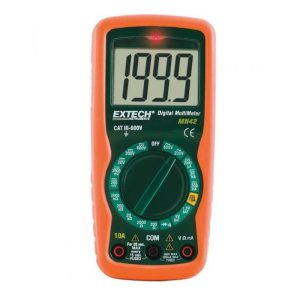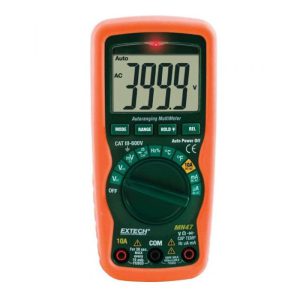The variety of possibilities on the market may be too much for someone shopping for a multimeter. An instrument known as a multimeter is capable of measuring a wide range of electrical characteristics, including voltage, current, resistance, frequency, capacitance, and more. For anyone who works with electricity, whether professionally or just for fun, it is a necessary tool.
But not every multimeter is made equal. others are more accurate and dependable, others have more features and functions, and some are better suited to particular uses than others. How do you tell which is right for you?
In response, we are here. We will compare 10 multimeters from MME-AE.com, one of the top online retailers for electrical measurement equipment in the UAE, in this article. We’ll examine their capabilities, attributes, advantages and disadvantages, client feedback, and costs.
Additionally, we’ll evaluate them in relation to one another and the opposition. You’ll know for sure by the end of this post which multimeter best suits your requirements and price range. So let’s get going.
Function Compact MultiMeter NCV EXTECH MN47
The EXTECH MN47 is a portable, reasonably priced multimeter that measures resistance, frequency, capacitance, temperature, diode/continuity, AC/DC voltage, and AC/DC current.
Additionally, it has a non-contact voltage detector (NCV) that can warn you of live wires without having to touch them.
It boasts a sizable LCD display with backlighting that clearly displays readings, a data hold feature that freezes the screen for later viewing, an auto power down feature that extends battery life, and a low battery indicator that lets you know when to change the battery.
Test leads, a temperature probe, a 9V battery, and a carrying bag are included.
Lightweight and compact design
simple to read and use
various ranges and functionalities
voltage detector without contact
LED backlighting
hold function for data
automatic power-off feature
Low battery warning
Included are test leads, a temperature probe, a battery, and a casing.
Cons:
For measurements of low current, not very accurate
Lack of real RMS features
without a min/max setting
lack of a relative mode function
Peak hold is absent
Customer evaluations:
Based on 12 customer reviews, the EXTECH MN47 has an overall rating of 4.5 out of 5 stars on MME-AE.com. The majority of buyers are satisfied with the product and give it high marks for its usability, simplicity, accuracy, and affordability. Some users are dissatisfied with the precision of low current measurements and the absence of genuine RMS functionality.
Price:
The EXTECH MN47 is available on MME-AE.com for AED 240, which is a fair price for a multimeter with a variety of features and capabilities. It costs less than several of its rivals, such the EXTECH MM570A and MN16A.
Comparison:
The EXTECH MN47 performs and features similarly to the EXTECH MN42, with the exception that the MN47 can additionally monitor frequency, capacitance, and temperature.
In addition, the MN47 costs AED 60 more than the MN42. In terms of features and functionality, the EXTECH MN47 is inferior than the EXTECH MN16A because the latter can also measure AC current, frequency, and capacitance.
Additionally, the MN16A incorporates a bargraph display with greater resolution. The MN16A costs AED 60 more than the MN47.
In terms of features and functionalities, the EXTECH MN47 is inferior than the EXTECH MM570A because the latter has a true RMS feature and can also measure duty cycle.
A dual display with lighting and a graphical mode that can display trends is also included with the MM570A.
Another feature of the MM570A is Bluetooth, which enables it to connect wirelessly to a smartphone or tablet and show readings on the Extech app. By AED 960, the MM570A is considerably more expensive than the MN47.
Conclusion:
Anyone seeking for a small, reasonably priced multimeter that features a non-contact voltage detector and can measure a variety of electrical properties may consider the EXTECH MN47. It comes with everything you need to start measuring and is simple to use and read.
However, if you require greater precision, functionality, or resolution, you might want to think about alternative possibilities like the EXTECH MN16A or the EXTECH MM570A.
Function Compact MultiMeter NCV EXTECH MN42
Similar to the MN47 multimeter but with less features is the EXTECH MN42. It is capable of measuring resistance, diode/continuity, AC/DC voltage, and AC/DC current.
Additionally, it contains a non-contact voltage detector (NCV), a large LCD display with backlighting, a data hold feature, an auto power off feature, and a low battery indicator. Test leads, a 9V battery, and a carrying case are included.
Lightweight and compact design
simple to read and use
standard capabilities and ranges
voltage detector without contact
LED backlighting
hold function for data
automatic power-off feature
Low battery warning
includes test leads, a battery, and a casing
Cons:
For measurements of low current, not very accurate
Lack of real RMS features
No measurement of frequency, capacitance, or temperature
without a min/max setting
lack of a relative mode function
Peak hold is absent
Customer evaluations:
Based on 10 customer reviews, the EXTECH MN42 has an overall rating of 4.4 out of 5 stars on MME-AE.com.
Most users of the product are pleased with it and give it high marks for simplicity, functionality, accuracy, and cost-effectiveness.
Some customers express dissatisfaction with the accuracy of low current measurements as well as the absence of measurements for frequency, capacitance, and temperature.
Price:
On MME-AE.com, the EXTECH MN42 costs AED 180, which is a fair price for a multimeter with basic features and capabilities. It costs less than several of its rivals, including the EXTECH MN16A and MN47.
Comparison:
In terms of features and functionality, the EXTECH MN42 is comparable to the EXTECH MN47, with the exception that the MN42 is unable to measure temperature, capacitance, or frequency. Additionally, the MN42 costs AED 60 less than the MN47.
Given that the MN16A can also measure AC current, frequency, and capacitance, the EXTECH MN42 is inferior to the MN16A in terms of features and functionality.
Additionally, the MN16A incorporates a bargraph display with greater resolution.
The MN16A costs AED 60 more than the MN42. In terms of features and functionalities, the EXTECH MM570A is superior to the EXTECH MN42 because it includes a true RMS feature and can also measure duty cycle.
A dual display with lighting and a graphical mode that can display trends is also included with the MM570A. Another feature of the MM570A is Bluetooth, which enables it to connect wirelessly to a smartphone or tablet and show readings on the Extech app.
By AED 1020, the MM570A is significantly more expensive than the MN42.
Conclusion:
Anyone seeking for a small, reasonably priced multimeter with the ability to measure fundamental electrical characteristics and a non-contact voltage detector may consider the EXTECH MN42.
It comes with everything you need to start measuring and is simple to use and read. However, if you require greater precision, functionality, or resolution, you may want to think about alternative possibilities like the EXTECH MN47 or the EXTECH MM570A.
Digital mini multimeter EXTECH MN15A
The EXTECH MN15A is a compact and lightweight multimeter that measures resistance, diode/continuity, AC/DC voltage, and current.
It includes a low battery indicator, an auto power down feature, a 2000 count LCD display, and a data hold feature. Test leads and a 1.5 V button battery are included.
Pros:
a compact and light design
Basic operations and ranges, easy to use
hold function for data
automatic power-off feature
Low battery warning
includes a battery and test leads
Cons:
For measurements of low current, not very accurate
Lack of real RMS features
No temperature, capacitance, frequency, or AC current measurement
without a min/max setting
lack of a relative mode function
Peak hold is absent
voltage detector without non-contact
Customer evaluations:
Based on 8 user reviews, the EXTECH MN15A has an overall rating of 4.3 out of 5 stars on MME-AE.com.
The majority of users are happy with the product and give it high marks for mobility, functionality, accuracy, and price. Some users express dissatisfaction with the battery life and button battery design.
Price:
Priced at AED 120 on MME-AE.com, the EXTECH MN15A is fair for a multimeter with minimal features and capabilities. It costs less than several of its rivals, including the EXTECH MN16A and MN47.
Comparison:
In terms of features and functionality, the EXTECH MN15A is comparable to the EXTECH MN10 except that it can also detect DC current. Additionally, the MN15A costs AED 30 more than the MN10 does.
Given that the MN42 can also measure AC current, the EXTECH MN15A is inferior to the MN42 in terms of features and functionality. The MN42 also features a lighted display and a non-contact voltage detector.
The MN42 costs AED 60 more than the MN15A. The EXTECH MM570A has more features and functions than the EXTECH MN15A, which includes the ability to detect AC current, frequency, capacitance, temperature, and duty cycle.
A genuine RMS capability, a dual display with backlight, and a graphical mode that may depict trends on the screen are additional features of the MM570A.
Another feature of the MM570A is Bluetooth, which enables it to connect wirelessly to a smartphone or tablet and show readings on the Extech app. By AED 1080, the MM570A is significantly more expensive than the MN15A.
Conclusion:
Anyone seeking for a compact, lightweight multimeter that can test fundamental electrical characteristics may choose the EXTECH MN15A. It comes with everything you need to start measuring and is simple to use and read.
However, if you require greater precision, functionality, or resolution, you may want to think about alternative possibilities like the EXTECH MN42 or the EXTECH MM570A.
Digital mini multimeter EXTECH MN16A
An improved model of the MN15A, the EXTECH MN16A also measures AC current, frequency, and capacitance.
It contains a 4000 count LCD display with bargraph that clearly displays readings and trends, a data hold feature that freezes the display for later viewing, an auto power down feature that preserves battery life, and a low battery indicator that lets you know when to change the battery. Test leads and a 9V battery are included.
Pros:
a compact and light design
simple to read and use
various ranges and functionalities
High-resolution bar graph display
hold function for data
automatic power-off feature
Low battery warning
includes a battery and test leads
Cons:
For measurements of low current, not very accurate
Lack of real RMS features
No measurements of temperature or duty cycle
without a min/max setting
lack of a relative mode function
Peak hold is absent
voltage detector without non-contact
Customer evaluations:
Based on 9 user reviews, the EXTECH MN16A has an overall rating of 4.6 out of 5 stars on MME-AE.com.
The majority of customers are satisfied with the product and give it high marks for its usability, simplicity, accuracy, and affordability. Some users are dissatisfied with the precision of low current measurements and the absence of genuine RMS functionality.
Price:
The EXTECH MN16A is available on MME-AE.com for AED 180, which is a fair price for a multimeter with a variety of features and capabilities. It is less expensive than some of its rivals, such the Extech MN47 and Extech MM570A.
Comparison:
In terms of features and functionality, the EXTECH MN16A is comparable to the EXTECH MN47, with the exception that the MN16A is unable to measure temperature. Additionally, the MN16A incorporates a bargraph display with greater resolution.
The MN16A costs AED 60 less than the MN47. In terms of features and functionality, the EXTECH MN16A is comparable to the EXTECH MN42, with the exception that the MN16A can additionally measure capacitance and frequency.
Additionally, the MN16A incorporates a bargraph display with greater resolution. The MN16A costs AED 60 more than the MN42. The EXTECH MM570A has more capabilities and functions than the EXTECH MN16A, which includes the ability to measure temperature and duty cycle.
A genuine RMS capability, a dual display with backlight, and a graphical mode that may depict trends on the screen are additional features of the MM570A.Another feature of the MM570A is Bluetooth, which enables it to connect wirelessly to a smartphone or tablet and show readings on the Extech app. By AED 960, the MM570A is considerably more expensive than the MN16A.
Conclusion:
Anyone seeking for a compact, lightweight multimeter that can measure a variety of electrical properties and has a high resolution display with bargraph may choose the EXTECH MN16A. It comes with everything you need to start measuring and is simple to use and read.
However, if you require greater precision, functionality, or resolution, you may want to think about alternative possibilities like the EXTECH MN47 or the EXTECH MM570A.
EXTECH EX320: 8 Function Mini MultiMeter + Non-Contact Voltage D for sale at extech-online.com



